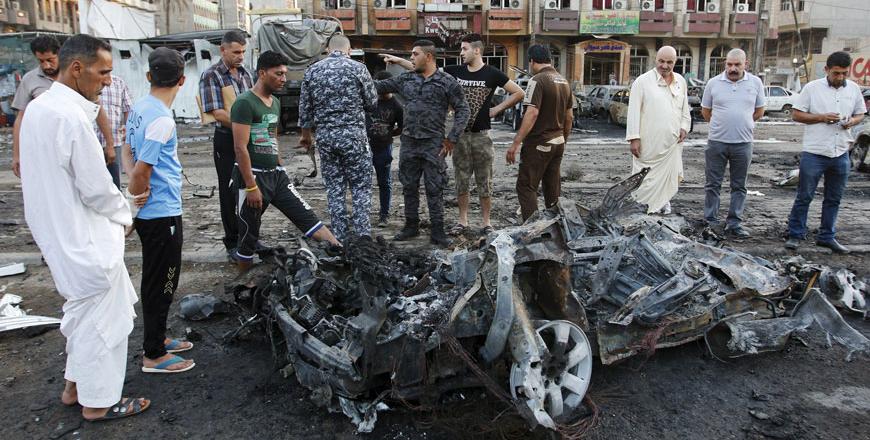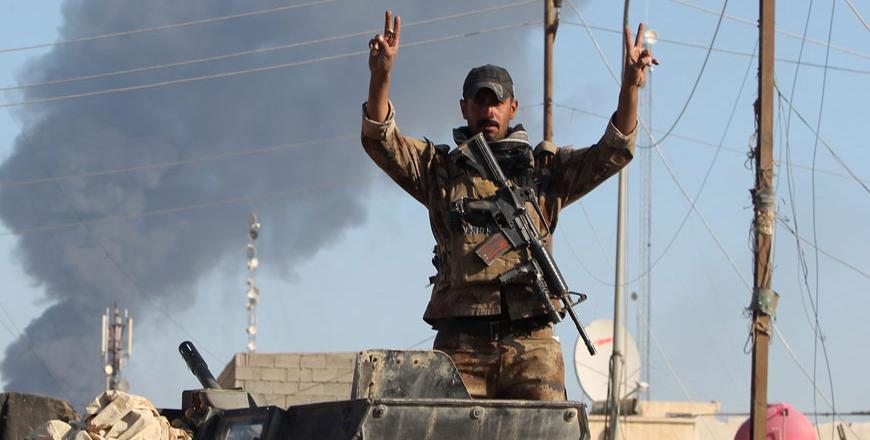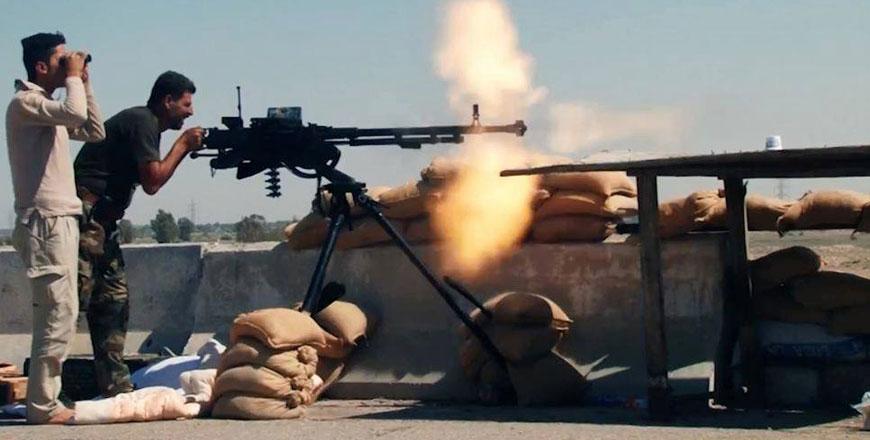You are here
Iraq’s stalemate in Ramadi raises doubts about US strategy
By AP - Sep 30,2015 - Last updated at Sep 30,2015

Residents gather at the site of a car bomb attack in Baghdad, Iraq, on Tuesday (Reuters photo by Khalid Al Mousily)
WASHINGTON — A summer of stalemate in the effort to reclaim the Iraqi provincial capital of Ramadi, despite US-backed Iraqi troops vastly outnumbering Daesh militants, calls into question not only Iraq's ability to win a test of wills over key territory but also the future direction of Washington's approach to defeating the extremist group.
The Ramadi standoff, with no immediate prospect of an Iraqi assault on the city, drags on even as the US prepares to makeover its approach to countering Daesh in Syria and congressional Republicans cite Ramadi as evidence of a failed American strategy. Republican Sen. John McCain of Arizona, a leading critic, says it's clear the US is not winning, "and if you're not winning in this kind of warfare, you are losing."
The Obama administration insists patience will pay off, even in Ramadi, where in May, Daesh won control against a much larger Iraqi force, shattering claims by US military officials that the group was on the defensive across Iraq.
Afterward, Defence Secretary Ash Carter said the Iraqis, who had no US-trained soldiers with them and had fled Ramadi, “showed no will to fight”.
The loss of Ramadi carried special significance for veterans of the long US war in Iraq. Dozens of US troops were killed there during the counterinsurgency fight to restore Iraqi government control in 2006; hundreds more died in combat across Anbar province, of which Ramadi is the capital.
A Ramadi counteroffensive, announced in July, was supposed to mark a turning point for Iraqi troops, who have proved to be no match for the determined Daesh militants. Instead it has sputtered, slowed by sectarian squabbles, debilitating summer heat and the extremists’ use of improvised bombs to create what amounts to a minefield around Ramadi.
Over the past two months, the Iraqi government has added about 3,000 US-trained Iraqi troops to the Ramadi operation, representing one-third of the total, US officials say. US officers in Iraq are working directly with Iraqi commanders to plan and execute the counteroffensive, but the Iraqis appear not to be in a hurry.
Instead of assaulting Daesh inside Ramadi, the Iraqis have struggled with a weeks-long effort to isolate the city by cutting off Daesh routes for resupply and reinforcement. That has been stymied by disputes between Iraqi federal police and Popular Mobilisation Forces, the Iranian-backed Shiite militias considered the most effective fighting force on the ground.
“We acknowledge that the Iraqis have not made any significant forward movement recently,” Col. Patrick Ryder, a spokesman for US Central Command, said Friday, adding that the US is urging Iraqi leaders to press ahead.
The slow pace has revealed Ramadi as a microcosm of the obstacles facing both the Iraqis and their American partners, including the competition for power and influence in Shiite-dominated Baghdad, the role of Iranian-backed militias in the fight against Daesh, and the deep flaws in Iraq’s security forces. As in Ramadi, the overall US-led campaign against Daesh is stalemated, US intelligence agencies believe.
The Obama administration believes a lasting solution to Daesh cannot be achieved by sending US combat forces back to Iraq. The US argues that the ultimate test is whether Iraq’s own security forces can be fortified to take back their country. If they cannot, according to Gen. Martin Dempsey, who stepped down this past week as chairman of the Joint Chiefs of Staff, then Washington will have to come up with a “Plan B”.
Some analysts doubt the plans for the Ramadi counteroffensive, noting that predominantly Sunni Ramadi is not the Shiite-dominated government’s highest priority.
“The Iraqi army remains weak despite American military aid,” Lina Khatib, a Middle East expert and research associate at the University of London’s School of Oriental and African Studies, said by e-mail. “It is simply not realistic to expect an army that almost crumbled just over a year ago in the face of the spread of IS [Daesh] to bounce back in such a short period of time.”
She was referring to the devastating collapse of Iraq’s army in Mosul in June 2014 and the fading expectation that Mosul, Iraq’s second largest city, can be retaken before President Barack Obama leaves office in January 2017. Early this year, US military officials said they expected an Iraqi counteroffensive in Mosul by May. Now there is talk of the city remaining in Daesh hands for the foreseeable future.
David E. Johnson, a retired army colonel and senior historian at the RAND Corp., believes the trouble runs deeper than just giving the Iraqi army more time to absorb US training.
“My view is that they’re just not capable of doing what it’s going to take” to recapture Ramadi, let alone succeed in the bigger challenge of retaking Mosul, Johnson said.
“Mosul is going to make Ramadi look like child’s play,” Johnson said.
Jim M. Dubik, a retired army lieutenant general who headed US training of Iraqi forces in 2007-08 and is now a professor at Georgetown University’s Centre for Security Studies, says the US and the government of Prime Minister Haider Al Abadi should be acting with more urgency.
“I really fear that our current approach may not work in time,” Dubik said. Abadi is under enormous pressure not only from the Daesh terror group but also from inside his own government, including those who favour giving Iranian-backed militias a lead role in Ramadi. Until more Iraqis become convinced that Abadi will prevail on the political front, he is likely to struggle on the military front, Dubik said.
Marine Brig. Gen. Kevin J. Killea, chief of staff at the US anti-Daesh command headquarters in Kuwait disputed the notion that the counteroffensive has stalled.
“There’s movement on both sides every day,” he said.
Related Articles
BAGHDAD — Iraqi forces recaptured territory east of Ramadi from Daesh militants on Tuesday, linking the Anbar provincial capital to a major
BAGHDAD — The Iraqi army will need the Kurds' help to retake Mosul, the largest city under the control of Daesh with the planned offensive e
ERBIL, Iraq/WASHINGTON — Iraqi Shiite militia fighters are tightening a noose around the Daesh-held city of Fallujah west of Baghdad a














